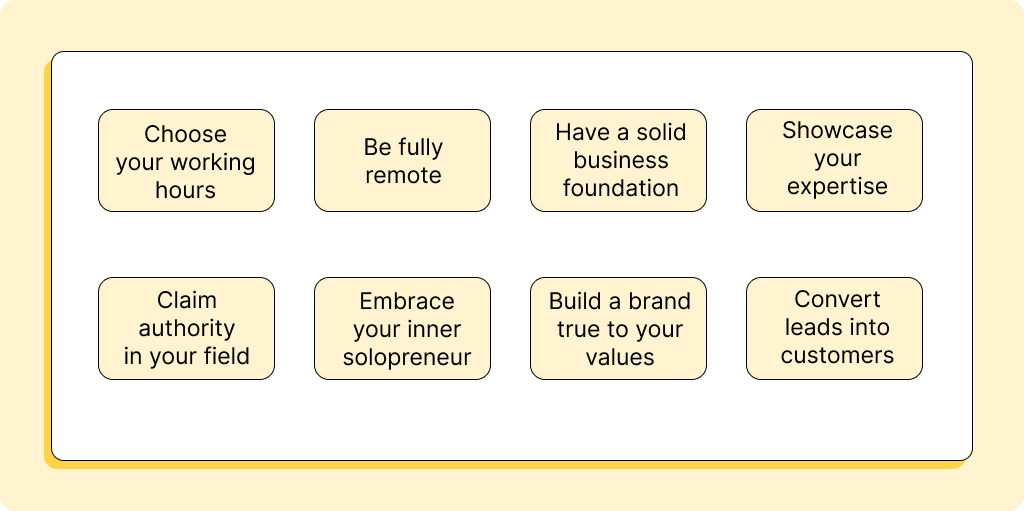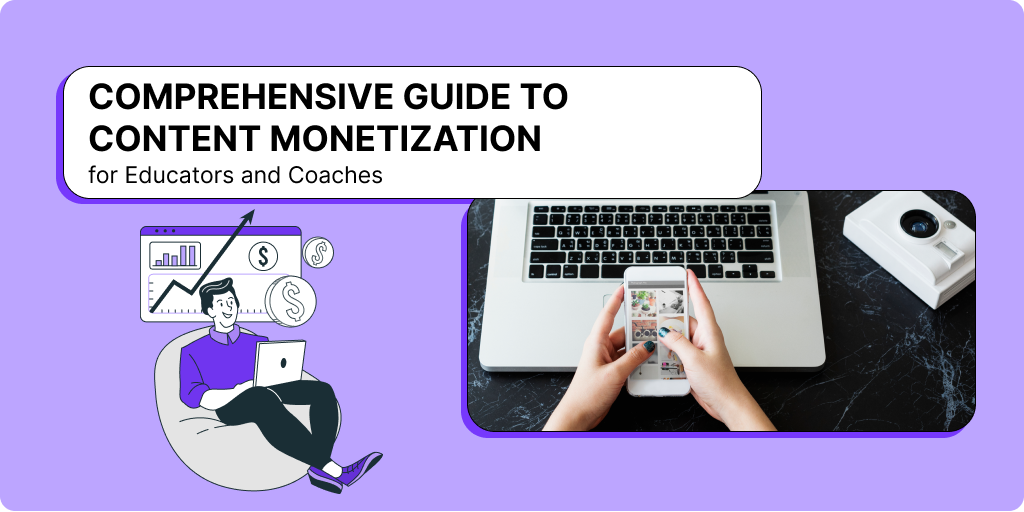Interested in turning your unique skills and expertise into a new profession teaching online? It’s becoming a wise decision for many people in your position. With an ever-growing demand for specialized teachers, online education has boomed recently. With a forecasted compound annual growth rate of 10.3% and a market size of $457.8 billion by 2026, it is not anticipated to slow down any time soon.
But let’s be honest, teaching people is not as simple as it may appear. Effective online instruction necessitates a delicate balance between field expertise, technological know-how, and the ability to translate this information into something that can be comprehended through a honed teaching competence.
If you’re a pro, the online teaching market offers you the chance to establish a prosperous business by assisting your audience in achieving specific results. And because internet teaching has eliminated the conventional restrictions that traditional education erected, there is no limit to what you may teach. Nevertheless, you must first understand how to teach online. And we’re here to provide the necessary tools to get started.
The benefits of online teaching in 2023

Three main ways to launch teaching online
Online teaching platform
Platforms for online education and tutoring are expanding quickly. Instructors of different levels of expertise may earn money online. Popular domains include language instruction, tutoring for secondary subjects, and continuing education. These systems also assist you in creating an online teaching area, providing resources, and providing frequent feedback to enhance your teaching abilities.
Teaching on online course marketplaces
What other choices are accessible if you don’t want to work for an online education platform? Frequently, course developers choose to create and sell their info products through online course marketplaces. Nevertheless, even though these course marketplaces make it simple to create and sell online courses, their simplicity comes at a significant cost to your online business.
- The marketplace provides you with little price control over your course. In addition, the marketplace can discount your courses at will and always retain a sizable portion of your sales as payment for the privilege.
- You have minimal influence over your marketing since your courses are forced to compete with a sea of rivals in your niche, all of whom are engaged in a pricing war to attract clients.
- Your student email list is not accessible to you. This implies that you have no method to contact your students directly, making it very hard to establish a long-term, recurring income connection with your course’s clients.
Build the online course business with Trible
Starting your own business where you have complete control over your teaching career is your best option. DIY courses and Trible are also relevant here. Trible is an all-in-one platform for content creators for launching, hosting and selling digital products, including online courses.
Starting your own business and teaching online from home is unquestionably for the lone entrepreneur. It’s where you can trickle your insights into well-curated lessons and watch them develop into worthwhile courses. And because it’s your business, you also get to decide the course prices.
How much money can you make teaching online?
It’s probably far more than you realize. Joining a teaching platform provides access to current students, pre-made technology, and content. Unfortunately, you will be paid an hourly fee determined by the platform. Thus you will never be reimbursed for the value of your instruction. The same rule applies to selling your courses on online course marketplaces.
Yet, you may establish your own fees when you offer online courses independently, on your own platform. And, if your course addresses a significant problem for consumers, you may set a premium fee.
A moderately priced, high-value course may readily sell for approximately $200. And if you meet the extremely attainable objective of selling one course every day, you’ll earn almost $73,000 per year.
Create a second course that achieves the same level of success, and your online course company is now well over the six-figure threshold, a revenue you could never have imagined when teaching on other people’s online platforms!
Does an online teacher need some specific certifications?

Kind of not. Several platforms view teaching credentials as an additional opportunity to demonstrate the quality of the education you provide, but not all platforms demand them. Yet, as previously noted, there are several methods to teach online from home without certification. It is essential to understand that students are more willing to pick professors with expertise and testimonials to support any claims of experience. And receiving positive testimonials is a direct result of being an excellent instructor.
It will be evident if you have not strived to establish good teaching skills. And here’s a little secret: effective teaching and salesmanship are more comparable than you may assume. While teaching online, you must understand the fundamentals of effectively presenting your thoughts in order to sell your knowledge. This does not require a certification, but it does require the ability to simplify complicated concepts in a way that is easily comprehended.
How to teach online: best tips
Nobody else can teach quite as you can, which is your greatest advantage as a teacher. Your personality, approach, and style distinguish you from other instructors in your field. Your distinctiveness is your strength. To this end, it’s crucial to recognize what you love teaching, what you teach well, and what you don’t.
Infuse your teaching with your own personality, and you’ll discover novel ways of efficiently transmitting your expertise to others, enabling you to become the master of teaching online your way.
Plan your online course
Many lessons make up a course. Each lesson must have its own objective and clearly contribute to achieving the course’s targeted conclusion.
A well-designed online course includes the following:
- Modules with clear definitions
- Achievable results
- tangible educational resources
- Reliable sources
- High-quality video and text content
- Skill-building assignments
Seems self-evident, right? A terrific lesson is both informative and enjoyable. Consider how you learnt a particular subject and use those features in your classes to create an engaging environment for your pupils.
Every kid has a unique learning style. Consider providing book suggestions, checklists, or handy Documents in your material so that students can instantly use their newfound knowledge after seeing your videos.
Master technology
Nobody wants to learn from someone they cannot see or hear. To teach online lessons from home, you will need a high-speed Internet connection and a recording system that captures the sound with exceptional clarity. And here’s another online teaching secret: you don’t have to spend a lot of money on recording equipment to do this. And once your online classroom is ready to go live, be careful to test the system to ensure that everything is functioning correctly.
Provide an effective working environment
As crucial as the technology you use to teach is where you teach. If you’ve never worked from home before, you’re in for a fresh experience. To teach lessons online, you will need a peaceful environment with decent acoustics for recording and no danger of being disturbed by humans, noisy traffic, or a demanding cat.
Communicate constantly

Communication is two-way. On the one hand, your classes provide students with the opportunity to share their questions, ideas, and opinions as part of the learning dialogue. On the other hand, it presents a chance to enhance your online teaching methods. In the majority of student-teacher relationships, this can range from periodic email check-ins to private coaching and questionnaires. Make it personal and address any student remarks that may arise. If you don’t, your pupils will notice.
Motivate learners
Which learning atmosphere inspires pupils the most? Online or in-person classes? Regardless of the learning mode, students are driven by the knowledge they can benefit from and are truly interested in. Hence, make your information as valuable as possible, preferably delivering the desired outcomes your students are seeking. Your students will be naturally motivated if they understand what they will get from your course and if you can express it concisely. It takes us to the next point.
Clear expectations
Your course should fulfill all of its promises. To do this, you must specify what students will and will not learn in your course. Your course expectations should be clearly stated in both your marketing and learning materials, as well as underlined in bold at the beginning of the course. So it is your responsibility to ensure that your course fulfills those promises. Think of it like tending to your garden. Remove the weeds to make room for the flowers to flourish.
Establishing explicit course expectations is analogous to allowing your garden to self-weed by identifying clients who will actually enjoy the information you deliver. And the best way to accomplish this is to be upfront about what is in your course and what students will gain from taking it.
Be involved
All outstanding in-person educators have the unique ability to monitor engagement levels and detect when they begin to decline. Yet, because you cannot often see your students when teaching online courses, it is difficult to measure this energy change.
To avoid this potential mistake, make your material as accessible as possible to all learning types. Give your pupils brief tasks, share interesting tales, and demonstrate activities as you discuss them to do.
At the conclusion of each lesson, solicit feedback in the page’s comments area. Based on the input you get, you may produce compelling new material or arrange live events such as Q&As, coaching sessions, and peer-to-peer evaluations to solve prevalent concerns.
Time to teach online
Your toolbox for beginning teaching online should be quite complete at this point. We’ve broken down the many paths that online teaching might lead you down and outlined the rewards and problems you’ll meet along the road for each. But before a student takes your first session, you’ll need to choose which method of teaching online best matches specific circumstances. To get the most out of teaching online from home, we advocate investing in yourself by establishing your own online teaching business.
 Putting on a Show: Trible's Guide to Crafting Outstanding PowerPoint Presentations
Putting on a Show: Trible's Guide to Crafting Outstanding PowerPoint Presentations







